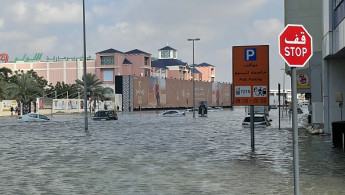What is cloud seeding and is it linked to Gulf flooding?
Authorities and communities across the United Arab Emirates were clearing debris on Wednesday after the UAE faced the heaviest rain in the nation’s history.
The UAE witnessed a record rainfall with 254 mm falling in Al Ain on Tuesday in less than 24 hours, according to the National Meteorology Centre (NMC).
The state-run WAM news agency called the rain Tuesday "a historic weather event” that surpassed “anything documented since the start of data collection in 1949."
Rain also fell in Bahrain, Oman, Qatar and Saudi Arabia.
The country's hereditary rulers offered no overall damage or injury information for the nation, as some slept in their flooded vehicles Tuesday night.
Dubai International Airport, one of the world's busiest, said it was facing significant disruptions after the heavy rains delayed or diverted flights and had impacted flight crews.
In Ras al-Khaimah, the country's northernmost emirate, police said one 70-year-old man died when his vehicle was swept away by floodwater.
Fujairah, an emirate on the UAE's eastern coast, saw the heaviest rainfall Tuesday with 145 millimetres (5.7 inches) falling there.
As discourse continues on the widespread flooding that lashed the Gulf country, multiple news reports have pointed to "cloud seeding" as one of the potential causes of the extreme weather conditions.
However, what is cloud seeding and did the initiative contribute to the heavy rainfall and storms?
What is cloud seeding?
Cloud seeding is a form of weather modification designed to increase rainfall and other types of precipitation.
The UAE kickstarted its groundbreaking operations in the 1990s and 2000s and is based in the Abu Dhabi emirate’s Al Ain, according to UAE-based news outlet The National.
Using a cloud that experts would evaluate as suitable, a plane linked to the cloud seeding initiative would be dispatched to Al Ain to “seed” using salt flares that attract water naturally to enhance rain.
The UAE’s NCM National Center of Meteorology previously stated that further research is required to uncover the programme’s impact over time.
Additionally, it has yet to exactly quantify how much rain falls since the creation of cloud seeding.
أمطار الخير… ومعالم #دبي الرائعة
— Dubai Media Office (@DXBMediaOffice) April 16, 2024
Snaps of #Dubai's rainy weather pic.twitter.com/MAROWXfQ89
It is mainly utilised by countries combating drought as it was famously used in some of the world’s biggest events.
From the 2008 Beijing Olympics to steering away radioactive clouds amid the Chornobyl disaster crisis, cloud seeding has been evidently used for various reasons.
Are there any concerns about cloud seeding - does this link to the UAE floods?
Legal and political issues arise within discussions by experts on whether cloud seeding is advantageous or not.
It could be argued that by seeding clouds in one region, those clouds would not carry rain to the next, which reduces rain downstream.
Additionally, a lack of transparency and consideration of its implications remains a question- particularly whether cloud seeding disrupts natural weather patterns.
An initial report by Bloomberg linked the heavy storms to cloud seeding.
The NCM’s specialist meteorologist Ahmad Habib told the US news outlet that seeding did take place on Sunday and Monday- but not on Tuesday.
However, the UAE government unit has since denied operations were conducted before the floods.
“The NCM didn't conduct any seeding operations during this event,” it said in a statement.
“One of the basic principles of cloud seeding is that you have to target clouds in its early stage before it rains. If you have a severe thunderstorm situation then it is too late to conduct any seeding operation.
“We take the safety of our people, pilots and aircraft very seriously. NCM doesn't conduct cloud seeding operations during extreme weather events.”
The NCM added that the planes reported to be dispatched in the days leading up to the floods were sent to take samples, not to seed clouds.
The New Arab approached the NCM for verification but did not respond during the time of publication.
Wired also suggested a number of other factors including the lack of drainage given the lack of regular rainfall- in opposition to cloud seeding being regarded as the prime cause of the UAE’s floods.
Climatologist Friederike Otto, a specialist in assessing the role of climate change on extreme weather events, told news agency AFP it was "highly likely" that global warming had worsened the storms.
Other experts indicated that as "warmer air can hold more water", climate change could lead to "heavier rainfall and extreme floods in other areas."
This article relied on a feature written by Austin Bodetti for The New Arab in 2021.





 Follow the Middle East's top stories in English at The New Arab on Google News
Follow the Middle East's top stories in English at The New Arab on Google News


